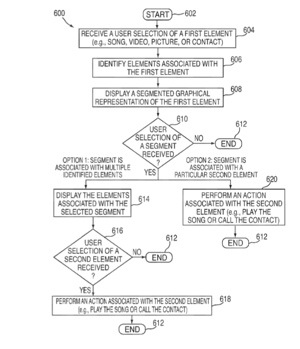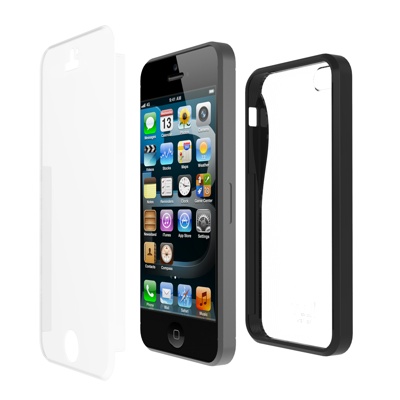Per a new patent (number 201110071977) at the US Patent & Trademark Office, Apple is considering using graphics and multi-touch gestures in lieu of, or perhaps in addition to, text on future iDevices for accessing music, contact lists and more.
According to the patent, entitled “Segmented Graphical Presentations for Recommending Elements,” systems, methods and machine-readable media are disclosed for providing segmented graphical representations of elements, such as songs, videos, pictures, graphics, or address book contacts. In some embodiments, an electronic device may identify remote and/or local elements based on a seed element and may display a segmented graphical representation of the seed element (e.g., a tiled album cover).
At least one of the segments may be associated with one or more of the identified elements. In response to receiving a user selection of a segment, the electronic device may perform any of a number of suitable actions based on the associated elements. For example, for remotely stored media elements, the electronic device can retrieve and play a preview of the media elements from a server. The inventors are Taido Nakajima and Pareet Rahul.
Here’s Apple’s background and summary of the invention: “Today’s portable electronic devices, such as cellular telephones and portable media players, have large storage capabilities. Users can therefore maintain large collections of music and other data types on their electronic devices. To add music and other files to their collections, users can download or purchase files from a server, such as from an online music store.
“Current portable electronic devices, however, are limited in their ability to present information to users. For example, portable electronic devices commonly have limited interfaces for presenting users’ music collections or for recommending songs for purchase. These electronic devices may display music collections or recommendations using textual lists of songs. Moreover, online music store interfaces for portable electronic devices may limit their recommendations to listing featured songs or to listing the most popular downloads.
“Systems, methods, and machine-readable media are disclosed for providing a segmented graphical representation of an element, such as a media element or an address book contact. The segmented graphical representation may be provided by any suitable electronic device, such as a portable media player or cellular telephone, and may be used as part of a user interface for recommending or identifying other elements that may be of interest to the user.
“In some embodiments, the electronic device can provide a segmented graphical representation of a seed element, such as a media element that is currently playing on the electronic device or an address book contact that the user is currently on a telephone call with. The segmented graphical representation may be an album cover, a picture of an artist or contact, or any other suitable graphic or picture. In some embodiments, the graphical representation may be segmented into a number of tiles or may include a mosaic.
“In some embodiments, the segments in a segmented graphical representation may each be associated with at least one element recommended based on the seed element. For example, the electronic device may identify a number of elements based on the seed element and may associate each of the segments with at least one of the identified elements. The identified elements may include elements that are stored on the electronic device and/or elements that are stored on a remote server. For simplicity, an element stored on a user’s electronic device may be referred to sometimes as a ‘local element, and an element stored on a server remote from a user’s electronic device may be referred to sometimes as a ‘remote’ element.
“In some embodiments, when identifying elements to recommend, an electronic device may prioritize identifying local elements over remote elements. For example, the electronic device may identify local elements, and may then determine whether the identified local elements meet a predetermined criteria (e.g., whether there are at least a predetermined number of local elements). If the local elements do not meet the predetermined criteria, the electronic device may identify remote elements. In other embodiments, the electronic device may prioritize identifying remote elements over local elements.
“In some embodiments, the electronic device may be configured to perform a suitable action in response to receiving a user selection of a segment from a segmented graphical representation. For example, if the segment is associated with multiple elements, the electronic device may present a display of the multiple elements.
“If the segment is associated with one element, the electronic device may perform an action associated with the one element. For example, for a remote media element, the electronic device may retrieve and play a preview of the remote media element from a server, and may provide the user with an option to purchase the remote media element. For a local media element, the electronic may play at least a portion of the local media element. For an address book contact, the electronic device may make a telephone call to the address book contact or provide more detailed information about the contact.”
— Dennis Sellers



